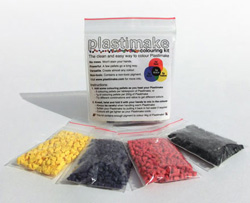Colouring


The Plastimake Colouring Kit is the clean and easy way to colour Plastimake.
- No mess. Won't stain your hands.
- Powerful. A few pellets go a long way.
- Versatile. Create almost any colour.
- Non-toxic. Contains a non-toxic pigment.
The Colouring Kit contains 5g of each colour: red, blue, yellow and black.
That's enough pigment to colour 1kg of Plastimake per colour!
Colouring Kit Instructions
- Add some colouring pellets as you heat your Plastimake
- 5 colouring pellets per tablespoon of Plastimake, or
- 1g of colouring pellets per 200g of Plastimake
- Try different combinations and ratios to get different colours
- Knead, twist and fold it with your hands to mix in the colours
- Always be careful when handling warm Plastimake
- Soften your Plastimake by putting it back in hot water if required
- Colours will get lighter as your Plastimake cools
The Plastimake Colouring Kit is available now for $15, free Aussie postage!
Plastimake Colouring Kit examples:
Painting
Once your Plastimake item has cooled you can paint it with a range of paints. We recommend:
- Acrylic paints
- Spray paints
Avoid using any solvent-based paints, some solvents will dissolve your Plastimake.
You won't be able to re-heat your item once it's painted, so make sure you're happy with the shape before you start painting!
Examples of painted Plastimake:
- Spray Painted Dinosaur masquerade mask
- Spray painted radio headset
- Sculpture painted with Acrylics
- Earrings painted with Acrylics
Mixing in pigments
Mix liquid or powered pigments into warm Plastimake to create an item with solid colour all the way through. Unlike painting, pigments that have been mixed into Plastimake will never scratch off.
The Plastimake Colouring Kit is the easiest way to mix coloured pigment into Plastimake. However, many other pigments will work too. We recommend:
- Alcohol based inks
- Acrylic paints and powders
- Vinyl and Epoxy dyes
- Most powdered pigments, including metallic and glow-in-the-dark powders
There are a few colourants that won't work well with Plastimake:
- Water based inks won’t blend in properly
- Some solvent-based paints will dissolve your Plastimake
Tips for mixing pigments into warm Plastimake:
- If you’re using a liquid pigment you’re likely to get some on your hands. Make sure you’re working in area where spills and drips won’t matter.
- You may need to place your Plastimake back in hot water to give yourself enough time to mix it all the way through. If it's not fully mixed in you'll get a marbled effect.
- The colour of your item will become a lot lighter as it cools and the Plastimake becomes hard and white.
- Use the Joining Parts technique to join differently coloured pieces of Plastimake into a final, multicoloured item. That's how we joined the green stems onto these red roses.
- Save your left-over pieces of coloured Plastimake, you can use these as a starting point for your next project!
Examples of pigments blended into Plastimake:
- Brooch repair dyed with alcohol based inks
- Wheelie bin repair dyed with alcohol based inks
- Experiments with blending glitter
- Chicken sculpture dyed with tree sap








